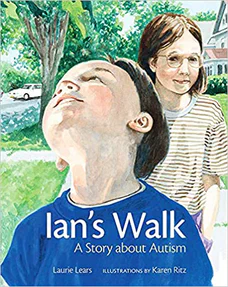Ian’s Walk
A Story about Autism
Written by Laurie Lears
Illustrated by Karen Ritz
32 pages
•
Published 1998 (Albert Whitman & Company)

Recommended Age Range: Kindergarten through 3rd grade.
Publisher's Summary:
Julie can’t wait to go to the park and feed the ducks with her big sister, Tara. There’s only one problem. Her little brother, Ian, who has autism, wants to go, too. Ian doesn’t have the same reactions to all the sights and sounds that his sisters have, and Julie thinks he looks silly. But when he wanders off on his own, she must try to see the world through his eyes in order to find him.

Dr. Annie's Takeaways
Recommended for: This book positions the siblings of autistic children as experts in their siblings’ preferences and interests (as many siblings are), and it reminds the reader that their sibling’s happiness and well-being is more important than what other people might be thinking. It’s best for the siblings of non-speaking or minimally verbal autistic children.
Would a child like it? It’s a serious story, but it’s also fairly compelling. Children who are at all interested in self-reflection will likely enjoy this book.
Tone: Sincere, thoughtful
Story Quality: The story is fairly simple on its surface (three children go on a walk; their little brother gets lost; the older sisters find him), but it has a lot of depth and warmth without being saccharine or unrealistic. It has some lovely, realistic character development, and even though the book is over 20 years old, it doesn’t feel too dated.
Illustrations: The illustrations look like candid photographs, and the expressions on the children’s faces are really realistic. The illustrations are not cute or stylized like many modern children’s books, but they’re effective and look authentic. Since ‘90s styles are back in fashion, the kids’ clothing doesn’t even look that dated!
Representation: Julie is a girl with an older sister Tara, a little brother Ian, and a mother. The family is White. Julie and Tara are not autistic; their little brother is (“he has autism”). Ian is non-speaking, flaps his hands, and has a variety of sensory processing differences (e.g., he enjoys watching ceiling fans, has sensitive hearing, doesn’t like the smell of flowers or being tickled but enjoys smelling bricks and pressing his face against the ground).
Psychological Practices: This book simultaneously validates some common frustrations of siblings of autistic children while gently encouraging them to empathize with their sibling and to feel proud of their knowledge of their sibling’s unique preferences. At first Julie expresses frustration and embarrassment about some of Ian’s behaviors (e.g., when he wants to smell some warm bricks on their walk, she tells him he looks silly; when he wants to eat cereal instead of pizza for lunch, she expresses frustration). After Ian gets lost and Julie needs to try to think like her little brother, she realizes that she knows what he likes and doesn’t like and that there is nothing wrong with these preferences. With this realization, she stops worrying about what other people might think and lets Ian enjoy the walk home in the way that he wants to (e.g., by spending time watching a ceiling fan at a diner). The book describes Ian as having autism, which it defines by stating that “Ian’s brain doesn’t work like other people’s. Ian sees things differently.” It then provides examples of how Ian experiences sight, sound, smell, touch, and taste differently than Julie does. Something I really appreciate about this book is that it shows many examples of things that Ian enjoys, rather than focusing on things he doesn’t like, and this sets the book up for a joyful representation of autism. It also celebrates Julie’s unique knowledge about her brother’s preferences, which is a role in which the siblings of autistic brothers and sisters can often feel a lot of pride. Siblings are often truly experts in their brothers and sisters in a way that almost no one else is, and reminding them of this can help them to find meaning in trying to empathize with and find joy in how their sibling experiences the world.
Concerns: None.
